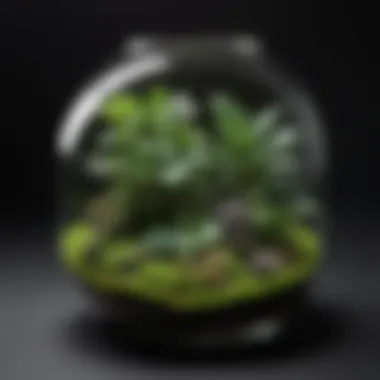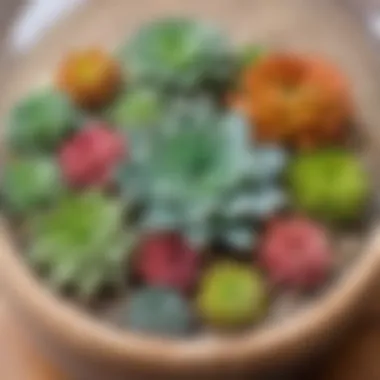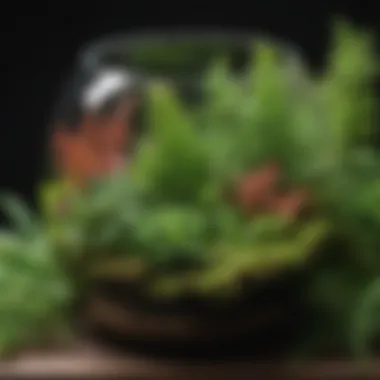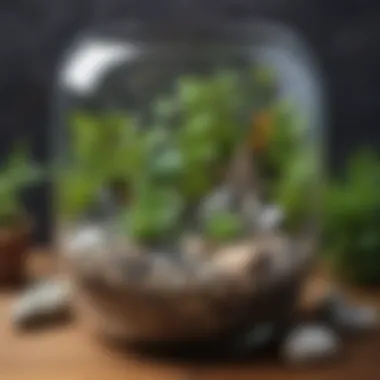Crafting Your Mini Ecosystem: A Comprehensive Guide to Building a Terrarium


Science Fun Facts
Terrariums are miniature ecosystems enclosed in glass containers, mimicking natural environments on a small scale. Did you know that the concept of terrariums dates back to the 1800s, where they were initially developed for scientific experimentation? These self-sustaining ecosystems require minimal maintenance and are excellent for introducing elements of nature into indoor spaces. Terrariums come in various sizes and designs, ranging from open containers to sealed glass jars, offering endless possibilities for creativity and innovation.
Introduction to Terrariums
Terrariums are miniature ecosystems encapsulated in glass containers, offering a unique opportunity to bring a slice of nature into your living space. In this comprehensive guide, we delve into the world of terrariums, exploring the nuances of crafting your own mini ecosystem. Whether you're a novice intrigued by the concept or an experienced enthusiast looking to expand your green repertoire, this guide will equip you with the essentials to embark on your terrarium adventure.
Understanding Terrariums
The Concept of Miniature Ecosystems
Miniature ecosystems, the foundation of terrariums, encapsulate the beauty and complexity of natural environments in a confined space. The key principle lies in creating a self-sustaining cycle where plants interact with their surroundings to thrive. This concept not only fosters a captivating visual appeal but also serves as an educational tool to understand the delicate balance within ecosystems. The allure of miniature ecosystems lies in their ability to showcase nature's resilience and interconnectedness in a compact form, making them a popular choice for nature enthusiasts of all ages.
Benefits of Having a Terrarium
The benefits of owning a terrarium extend beyond aesthetic appeal. Terrariums serve as low-maintenance green companions, requiring minimal watering and care compared to traditional houseplants. They act as natural air purifiers, enhancing indoor air quality and creating a healthier environment. Additionally, terrariums offer a unique opportunity for hands-on learning, allowing individuals to witness plant growth and ecosystem dynamics up close. Their versatility in design and plant selection make them an ideal choice for adding a touch of greenery to any space.
Ideal Environments for Terrariums
Creating an ideal environment is crucial for the success of a terrarium. These closed ecosystems thrive in indirect sunlight, making them perfect for placement in well-lit indoor areas. The controlled environment within a terrarium mimics the natural conditions plants require to flourish, ensuring optimal growth. By carefully selecting suitable plant species and maintaining appropriate humidity levels, you can establish a sustainable ecosystem that will thrive for years to come.
Types of Terrariums
Open vs. Closed Terrariums
The choice between open and closed terrariums hinges on the level of maintenance you prefer. Open terrariums, featuring an opening for airflow, require more frequent watering and monitoring. On the other hand, closed terrariums, sealed to create a self-sustaining ecosystem, demand minimal upkeep once established. Each type offers a distinct experience, catering to varying preferences and commitment levels.
Aquatic Terrariums
Aquatic terrariums, also known as paludariums, house a combination of aquatic and terrestrial plants alongside aquatic animals. These immersive setups replicate aquatic ecosystems, providing a captivating underwater landscape within a glass enclosure. Maintaining water quality and balancing flora and fauna dynamics are essential for the vitality of aquatic terrariums.


Desert Terrariums
Desert terrariums simulate arid landscapes, hosting succulents, cacti, and sand-loving plants. These drought-resistant ecosystems thrive in well-drained soil with minimal watering, mimicking the conditions of desert regions. Desert terrariums offer a striking visual aesthetic with their adaptation to dry climates, making them a popular choice for those fascinated by desert flora.
Rainforest Terrariums
Rainforest terrariums mirror the lush diversity of tropical rainforests, housing a vibrant array of plant species. The dense greenery, coupled with high humidity levels, creates a tropical oasis within a glass enclosure. Replicating the moist, fertile conditions of rainforests is essential for nurturing the diverse flora within these terrariums, offering a glimpse into the rich biodiversity of tropical regions.
Selecting the Right Container
Selecting the right container plays a crucial role in the successful creation of a terrarium. The container is not just a vessel but also the frame for your mini ecosystem, impacting the visual appeal and functionality of the terrarium. When choosing a container, factors like size, shape, and material must be considered to ensure the optimal environment for the plants within.
Choosing the Perfect Glassware
Glass Containers for Terrariums
Glass containers are a popular choice for terrariums due to their transparency, which allows for a clear view of the entire ecosystem. Transparency is essential for observing plant growth, moisture levels, and any changes within the terrarium. Moreover, glass containers provide a sleek and modern aesthetic, enhancing the overall appeal of the terrarium. One key characteristic of glass containers is their versatility; they come in various shapes and sizes, accommodating different terrarium designs and plant varieties. While glass containers may be fragile and more prone to breakage than other materials, their visual advantages and functionality make them a preferred choice for showcasing your mini ecosystem.
Alternative Container Options
Alternative container options offer a diverse range of choices beyond traditional glassware. Materials like acrylic, plastic, or ceramic provide unique aesthetics and may be more durable than glass. Acrylic containers, for instance, are lightweight and less likely to shatter, making them safer for use in homes with children or pets. Each alternative material brings its own characteristics to the terrarium, contributing to its visual appeal and practicality. However, some materials may not offer the same level of transparency as glass, limiting visibility into the terrarium's interior. Despite this limitation, alternative container options provide flexibility in design and may be better suited for specific terrarium styles or environments.
Considerations for Container Size
When determining the size of the container for your terrarium, it is essential to consider the needs of the plants and the overall aesthetics of the display. The container size directly impacts the amount of space available for plant roots to establish and spread. Too small of a container can restrict plant growth and lead to overcrowding, while a container that is too large may cause issues with moisture retention and plant stability. Matching plant selection to the container size is crucial for creating a balanced and visually pleasing terrarium. Additionally, allowing sufficient space for plant growth ensures that the ecosystem remains sustainable in the long term.
Matching Plant Selection to Container Size
Matching the right plants to the container size involves considering the mature size of the plants and their growth habits. Compact plants are well-suited for smaller containers, while larger plants require more room to thrive. By understanding the space requirements of the selected plant species, you can create an environment where each plant can flourish without overcrowding or competition for resources. Proper matching of plants to container size fosters harmony within the terrarium and promotes healthy plant growth.
Space for Plant Growth
Allocating space for plant growth is essential for establishing a balanced ecosystem within the terrarium. Plants need room to expand their root systems and foliage without being constrained by the container walls. Sufficient space allows for adequate air circulation, reducing the risk of mold or mildew development. When selecting a container, consider not only the current size of the plants but also their potential growth in the future. By providing ample space for plant growth, you create an environment where the plants can thrive and the terrarium can maintain its visual appeal over time.


Selecting and Preparing Plants
Selecting and preparing plants is a crucial step in the terrarium creation process. The plants you choose will determine the overall aesthetics and functionality of your mini ecosystem. When selecting plants for your terrarium, consider factors such as size, growth patterns, and light requirements. Opt for small, slow-growing plants that thrive in low light conditions. Succulents, air plants, and ferns are popular choices due to their adaptability to terrarium environments.
Choosing Suitable Plants
Types of Plants for Terrariums
Types of plants play a significant role in the success of your terrarium. Succulents, known for their water retention capabilities, are excellent choices for closed terrariums as they require minimal watering. Mosses add a touch of lush greenery and thrive in moist environments, making them ideal for rainforest-themed terrariums. As for carnivorous plants like Venus flytraps, they not only add a unique aesthetic but also serve a functional purpose by controlling insect populations within the terrarium.
Compatibility of Plant Species
Ensuring the compatibility of plant species is vital to maintaining a harmonious terrarium ecosystem. When combining plants in a terrarium, consider factors such as water and light requirements, growth rates, and root systems. Choose plants that have similar needs to prevent competition for resources. Avoid pairing plants with conflicting care requirements to promote their overall health and longevity within the terrarium.
Planting and Arranging
Planting and arranging your chosen vegetation is where creativity meets horticulture. Creating layers in your terrarium is essential for establishing a visually appealing and functional ecosystem. Begin with a drainage layer of pebbles or activated charcoal to prevent waterlogging, followed by a layer of potting mix suitable for your plant selection. When arranging plants, consider their growth habits and ensure adequate spacing to allow room for expansion. Experiment with different plant heights and textures to create a dynamic and visually interesting composition.
Creating Layers in Your Terrarium
The layering technique is crucial for ensuring proper drainage and root aeration within the terrarium. Ensure each layer serves a specific purpose; the bottom layer prevents waterlogging, while the middle layer acts as a foundation for root growth. The top layer, typically composed of decorative materials like pebbles or moss, adds a finishing touch to your terrarium's design.
Placement and Spacing of Plants
Strategic placement and spacing of plants are essential for maintaining plant health and promoting optimal growth. Consider factors such as light exposure and watering accessibility when positioning your plants. Allow each plant ample space to prevent overcrowding and competition for sunlight and nutrients. Arrange plants of varying heights to create visual interest and balance within the terrarium.
Adding Decorative Elements
When it comes to creating a terrarium, the addition of decorative elements plays a crucial role in enhancing the overall aesthetic appeal and visual interest of the mini ecosystem. These elements not only add a touch of creativity but also contribute to the functionality and balance within the terrarium. By carefully selecting and incorporating decorative elements, you can create a visually captivating display that reflects your personal style and preferences. It's important to consider the size, color, texture, and theme of the decorative elements to ensure they complement the plants and container appropriately.
Enhancing Aesthetics


Rocks, Pebbles, and Sand
Rocks, pebbles, and sand serve as foundational elements in a terrarium, offering both aesthetic value and practical benefits. The varying sizes and colors of rocks and pebbles create depth and visual interest, mimicking natural landscapes within the confined space of the terrarium. Sand, on the other hand, provides a stable base for the plants and helps with drainage. Their textured surfaces add dimension to the terrarium while also promoting proper airflow and water circulation.
Miniature Figurines or Ornaments
Miniature figurines or ornaments inject a whimsical charm and personality into the terrarium. These tiny decorations can range from miniature animals and buildings to fantasy creatures, adding a touch of playfulness to the mini ecosystem. They serve as focal points or accents within the terrarium, creating visual points of interest and inviting closer inspection. When choosing figurines or ornaments, consider their size in relation to the plants and container to maintain a sense of scale and proportion.
Moss and Lichen
Moss and lichen contribute to the naturalistic appeal of a terrarium, providing a lush and verdant texture to the miniature landscape. These botanical elements not only enhance the aesthetics of the terrarium but also help regulate moisture levels within the environment. Moss acts as a natural carpet, covering the soil and creating a soft, velvety surface, while lichen adds a delicate touch of greenery to rocks and driftwood. Their presence adds a sense of realism and biodiversity to the terrarium, transforming it into a thriving microcosm of nature.
Creative Personalization
Theme-Based Decor
Theme-based decor allows you to create a cohesive and unified look for your terrarium, tying together all elements with a central motif or color scheme. Whether you opt for a botanical theme with faux mushrooms and forest creatures or a minimalist theme with geometric shapes and patterns, thematic decor provides a cohesive narrative for your mini ecosystem. This approach can elevate the visual impact of the terrarium and create a harmonious environment that resonates with your aesthetic sensibilities.
DIY Decorative Ideas
DIY decorative ideas enable you to infuse a personal touch into your terrarium, making it uniquely yours. From crafting miniature accessories to repurposing everyday items as decor, the DIY approach encourages creativity and resourcefulness. By incorporating handmade elements, you can tailor the terrarium to suit your preferences and showcase your craftsmanship. DIY decorations add a custom, one-of-a-kind element to the terrarium, making it a truly personalized expression of your style and imagination.
Caring for Your Terrarium
In this section, we delve into the crucial aspect of caring for your terrarium. Proper maintenance is key to ensuring the longevity and health of your mini ecosystem. By understanding the specific needs of your terrarium, you can create a thriving environment for your plant life. This section highlights essential maintenance routines and practices that will help you preserve the beauty of your terrarium over time.
Maintenance Tips
Watering Schedule
When it comes to caring for your terrarium, establishing a consistent watering schedule is paramount. Watering is essential for plant growth and overall health within the confined environment of a terrarium. By maintaining a regular watering regimen, you can provide your plants with the necessary hydration to thrive. A well-executed watering schedule can prevent issues such as overwatering or underwatering, which can lead to plant stress or even death. It is important to tailor your watering frequency based on factors like plant species, soil moisture levels, and terrarium size to ensure optimal growth.
Pruning and Trimming Plants
Pruning and trimming plants serve as vital components of terrarium maintenance. Regular pruning helps control plant growth, removes dead or damaged foliage, and promotes healthy development. By trimming away excess growth, you can prevent overcrowding within the terrarium, allowing each plant to access sufficient light and resources. Pruning also encourages new growth and helps maintain the desired shape and appearance of your plants. However, it is crucial to use sterilized tools to avoid introducing diseases or pathogens to your terrarium ecosystem.
Preventing Mold and Pests
Preventing mold and pests is critical in ensuring the well-being of your terrarium. Mold growth can occur due to excess moisture or decaying plant matter, posing a threat to plant health. Regularly inspecting your terrarium for signs of mold and promptly addressing any issues can prevent its spread. Additionally, implementing preventive measures such as proper ventilation and avoiding overwatering can help mitigate mold formation. Similarly, monitoring for pests like aphids or mealybugs and taking proactive steps to combat infestations can safeguard your terrarium from potential damage and nutrient depletion.







